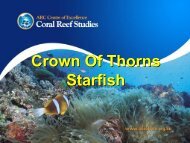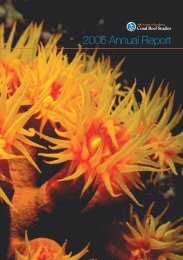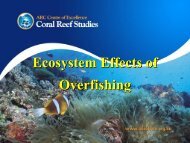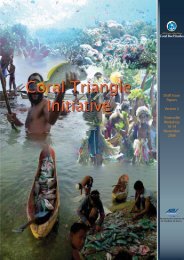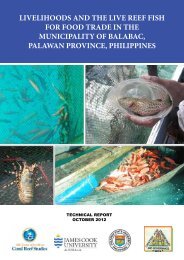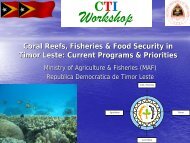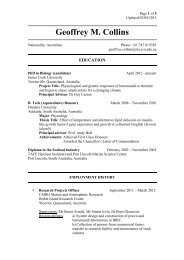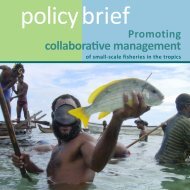Download - ARC Centre of Excellence for Coral Reef Studies
Download - ARC Centre of Excellence for Coral Reef Studies
Download - ARC Centre of Excellence for Coral Reef Studies
Create successful ePaper yourself
Turn your PDF publications into a flip-book with our unique Google optimized e-Paper software.
Continued from page 6…“This gene mapping project has both practical and scientificsignificance. It will help us to understand how corals buildreefs, and why they fail to do so when they are under stress.“It will enable us to predict, with much greater confidence,how corals are likely to respond to changes in the oceans suchas warming, acidification, the spread <strong>of</strong> coral diseases, andvarious <strong>for</strong>ms <strong>of</strong> pollution.”The mapping <strong>of</strong> the coral genome is a joint undertaking bythe <strong>ARC</strong> <strong>Centre</strong> <strong>of</strong> <strong>Excellence</strong> <strong>for</strong> <strong>Coral</strong> <strong>Reef</strong> <strong>Studies</strong> andthe Australian Genome Research Facility, in collaborationwith the ANU, The Walter and Eliza Hall Institute, andThe University <strong>of</strong> Queensland.“This is a fabulous example <strong>of</strong> a multi-nodal collaborationamong many players, creating a new world-class researchprogram in coral reef genomics”, says <strong>Centre</strong> Director and<strong>ARC</strong> Federation Fellow, Pr<strong>of</strong>essor Terry Hughes.The sequencing project builds on earlier collaborationsbetween the ANU and James Cook University, sponsoredby the <strong>ARC</strong> Special Research <strong>Centre</strong> <strong>for</strong> the MolecularGenetics <strong>of</strong> Development under the Directorship <strong>of</strong>Pr<strong>of</strong>essor Robert Saint.Future plans <strong>for</strong> the <strong>Centre</strong> include mapping the genome<strong>of</strong> the coral’s symbiotic partner, the din<strong>of</strong>lagellateSymbiodinium—a primitive marine plant, with its associatedmicrobes. Symbiodinium is essential <strong>for</strong> coral growth becauseit carries out photosynthesis and provides the coral withcarbohydrates and energy.A bacterial community is also important <strong>for</strong> the health <strong>of</strong>the coral animal. Only by understanding all communityinteractions, and how they change under conditions <strong>of</strong>stress, will we be able to understand how the entire coralorganism functions.For more in<strong>for</strong>mation contact Pr<strong>of</strong>essor Terry Hughes atterry.hughes@jcu.edu.au or on + 61 7 4781 4000.Great Barrier <strong>Reef</strong> corals. Photos courtesy <strong>of</strong> the <strong>ARC</strong> <strong>Centre</strong> <strong>of</strong><strong>Excellence</strong> <strong>for</strong> <strong>Coral</strong> <strong>Reef</strong> <strong>Studies</strong>32 <strong>ARC</strong> <strong>Centre</strong> <strong>of</strong> <strong>Excellence</strong> <strong>for</strong> <strong>Coral</strong> <strong>Reef</strong> Discovery <strong>Studies</strong>• Spring 2009 • Page 7




